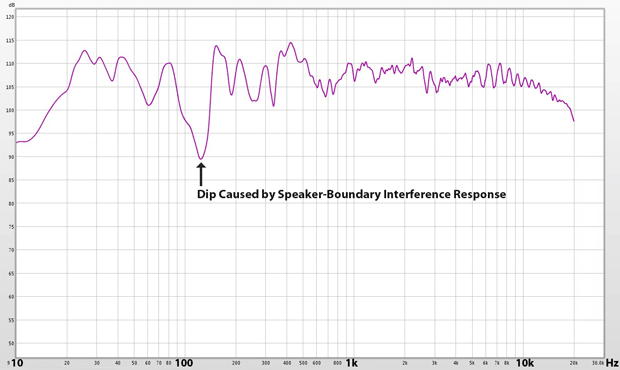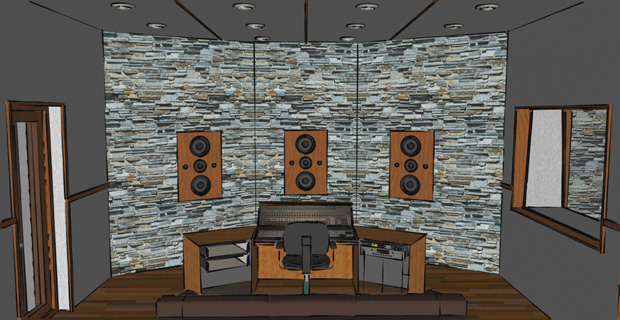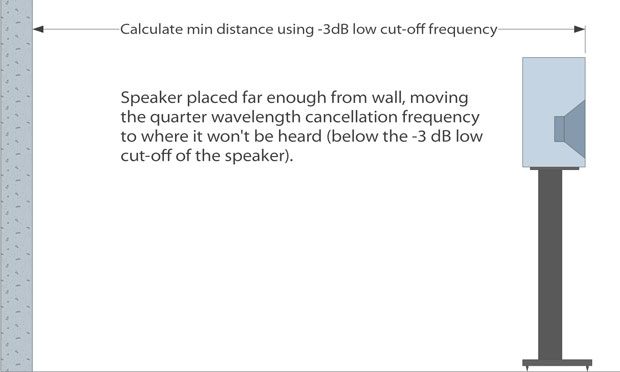Speaker Placement and Reflections from Nearby Walls
Is Speaker-Boundary Interference Killing Your Bass?
PART: 1 2 3 4
Not hearing enough bass through your monitors? The distance between your room boundaries and speakers has a huge impact on your bass performance.
Speakers are more omnidirectional at low frequencies, meaning bass waves radiate in all directions, causing a rumbling ruckus. Bass waves radiate backward from your speakers, toward the wall in front of you… and when they hit the wall, they reflect.
When the reflected sound wave bouncing off your wall combines with the source sound wave coming from your speaker, it creates acoustic interference.
If your speaker is one quarter wavelength from the wall for a certain frequency, wave cancellation occurs at that frequency. This causes a horrid dip, notch or null in the frequency response.
 Animation of a sound wave reflecting off a boundary. Courtesy of Dan Russell at Penn State University. After reflection, the sound pressure (charted amplitude) is zero at 1/4, 3/4, 5/4, etc wavelength from the boundary (the points in the wave that don’t move). These points are called nodes. These are the places where the direct and reflected sound are always cancelling each other out (destructive interference).
Animation of a sound wave reflecting off a boundary. Courtesy of Dan Russell at Penn State University. After reflection, the sound pressure (charted amplitude) is zero at 1/4, 3/4, 5/4, etc wavelength from the boundary (the points in the wave that don’t move). These points are called nodes. These are the places where the direct and reflected sound are always cancelling each other out (destructive interference).
The amount of cancellation depends on the strength of the reflection relative to the direct sound. The animation shows them as equal strength, which does not actually happen in your room… but your bass reflections are still strong enough to cause serious problems!
Let’s say this is a 60 Hz sound wave. If you place your speaker on a node, it will cause a null or dip in the frequency response at 60 Hz.
1/2 wavelength from the wall is an anti-node, where the two waves have added together (constructive interference). If you place your speaker on an antinode, it will cause a peak or boost in the frequency response at 60 Hz. Shortly after the reflection in this animation, the direct and reflected waves are superimposed and a standing wave is formed.
Cancellation always occurs at ¼ the wavelength from your wall, regardless of the phase of the wave hitting the wall.
Why? Because a quarter wavelength from your wall, the total travel difference (for a wave reflecting back on itself) is half a wavelength. This means the reflected and direct sound are 180 degrees out of phase.
When two sound waves of equal magnitude are 180 degrees out of phase, phase cancellation occurs — they cancel each other out because they are equal and opposite. The diagram below shows how it happens.
Speaker-Boundary Interference Response (SBIR)

So, if your direct and reflected sound waves are similar in strength, and half a wavelength out of phase, the waveforms mostly annihilate each other.
This is called speaker-boundary interference response (SBIR), listener-boundary interference response (LBIR) or the boundary effect. All these terms boil down to the same thing: boundary-induced comb filtering.
SBIR causes deep dips in the bass response below a certain frequency, and it can affect your low frequency response even more than room modes.

Frequency response measurement at the listening position showing a dip / null caused by the speaker-boundary effect.
Unfortunately, you can’t correct for SBIR using EQ. If you apply a correction filter to try to boost the signal at a cancellation frequency, you will also boost the refection that’s causing the interference!
To address SBIR you have only two weapons in your arsenal: speaker placement and acoustic treatment.
So… how far from my walls should I place my speakers?
If your speakers are placed in front of your wall (as opposed to flush-mounted in the wall), boundary interference will always be there to mess with you.
You may not be able to avoid SBIR completely, but you can position your speakers to minimize the peaks and nulls that wreak havoc on your sound.
If you’re using nearfield monitors, you can visualize the influence of wall reflections using this wall bounce SBIR calculator by Thomas Barefoot of Barefoot Sound. Thomas makes epic studio monitors (like the MiniMain12, a 4-way active monitor).
-
The first cancellation notch caused by SBIR is usually about two thirds of an octave wide. To prevent it from coloring your sound, you want to place your speakers so that this notch is either
- At a high enough frequency so it can be treated using absorption.
- Outside the frequency range that your speakers reproduce.
Below are three approaches you can take.
Option Awesome: Flush-mounted studio monitors!
The only way to truly thwart SBIR is to flush mount your studio monitors in a hard, rigid wall. This is how main monitors (aka, ‘mains’) are mounted in million dollar recording studio control rooms.
If your studio monitor speakers are designed to be flush-mounted, the best place for them is in your wall — your speaker baffles flush with the wall surface. Your front wall becomes a giant speaker baffle. An infinite baffle.

Proper flush mounting means no front wall reflection… and that means no speaker boundary interference from your front wall!
Your speakers and wall sing in harmony. Also, flush mounting increases acoustical loading which helps drive your monitors, making them more efficient at low frequencies. It really is that awesome.
If your speakers aren’t specifically designed to be flush-mounted but you still want to give it a shot, check out these guidelines by Genelec, and consult your speaker manufacturer before proceeding.
Flush mounting vs soffit mounting
Flush mounting is sometimes misleadingly called “soffit mounting”. Soffit-mounted speakers are a special case: they are flush-mounted above a soffit (if you have a recessed ceiling, the underside of the ceiling overhang is what an architect would call the soffit).
Soffit mounting is not ideal as it requires the monitors to be angled steeply down toward the listener. Also, the space below the soffit can become resonant.
Option 2: Place speakers as close as possible to the front wall (where flush mounting is the ideal)
Even if you can’t flush mount your monitors, you can still take advantage of proximity to the wall behind the speaker.
This is your second best choice for studio monitor placement. It’s what I generally recommend for home studio setups that use nearfield monitors (unless you’re using very small* speakers).
*Small speakers are less directional at mid frequencies, which may cause significant low-mid frequency energy to radiate backward and reflect off the wall behind the speakers. This would shift the cancellation dip to the low-mid band, causing audible coloration.
As you move your speakers closer to the wall, the cancellation notch in your frequency response moves to higher frequencies.
That’s great news because higher frequencies are more directional (they radiate less energy backward), and they are easier to manage using acoustic treatment.
Generally, a gap of 0 to 8 inches (0 to 20 cm) between your speakers and front wall is a good starting point to minimize coloration caused by SBIR. But, check your loudspeaker specs for a recommended minimum distance.
For example, Genelec recommends a minimum distance of 2 inches (5 cm) to allow for amplifier cooling and rear opening sound radiation.
At very close distances, 4 inch thick absorptive acoustic panels behind the speakers may help tame the cancellation notch. Broadband bass traps would be better. As speaker-wall distance increases, treatment becomes less practical.
The effectiveness of absorption behind your speakers also depends on speaker directivity. If you’re using dipole speakers (used in some hi-fi setups), absorption will help more than if you’re using monopole speakers. Most speakers are monopole.
Quick tip: Placing your speakers close to the front wall helps drive them, providing more output and less distortion. However, it also causes low shelving, a boost in the bass response (akin to the proximity effect that happens when you place a sound source close to a directional microphone). You can easily tame this with EQ. Some speakers have boundary gain compensation (BGC) control, which lets you apply an approximate correction. Better yet, you can use a calibrator to create an EQ curve that accurately compensates for the boundary effects you’re experiencing.

Option 3: Place speakers far enough away from the front wall to reduce comb filtering
As you move your loudspeakers further from the walls, you reduce the minimum boundary interference frequency.
You can reduce coloration caused by boundary interference by placing your loudspeakers far enough away from the front wall, so that the lowest frequency cancellation notch is outside the frequency range that your speakers reproduce.
This is a good option if you have a large room.
If dfwall is the distance to the wall behind your speaker, you can calculate the quarter wavelength cancellation frequency using this formula:
fc = c / 4dfwall
Where fc is the center frequency of the cancellation notch and c is the speed of sound (at sea level, in dry air, at room temperature, the speed of sound is 343 m/s, or 1125 f/s).
In general, for two-way speakers you absolutely want to prevent nulls in the 40-80 Hz range, and try your best to avoid them between 80-200 Hz. For your typical studio monitor, that means the recommended speaker-to-wall distances are:
Good: Flush-mounted or as close to wall as possible (see manufacturer recommendations)
Okay: Up to 1 m (3′-3″)
Avoid: 1-2.2 m (3′-3″ to 7′-3″)
Good: Over 2.2 m (7′-3″)
But these are just a general guidelines. The recommended distance for you depends on the low frequency performance of your loudspeakers.
You want to push the cancellation notch below the low frequency cut-off of your speakers.
You can calculate dmin, the minimum distance from your speaker to the wall behind it, using this formula:
dmin (feet) = 1.4(1125) / 4f-3dB
or
dmin (meters) = 1.4(343) / 4f-3dB
Where f-3dB is your loudspeaker’s low cut-off frequency. For example, if your speakers have a -3 dB low cut-off at 55 Hz, dmin = 2.18 meters (7′-3″).

However, for large speakers with a low cut-off frequency (like active 3-way main monitoring systems), the distance needed to bump the cancellation frequencies below the LF cut-off simply becomes too big for most listening rooms and control rooms.
Also, at these distances, reflections from the sidewalls, back wall, floor and ceiling become big players in the boundary interference game. In this case, flush mounting is the only reliable option if you care about critical listening.
Bass suckout and listening distance from your rear wall
In small rooms, the strongest distortions in your bass response tend to be from reflections off the rear wall, behind your listening position. This is because most of the sound energy leaving your speakers is fired toward your rear wall.
You have strong bass buildup there due to room modes (causing a peak at the rear wall and a null in the center of your room), but your back wall also causes major boundary interference.
Ethan Winer frequently talks about how serious this can be. You get peaks at 1⁄2, 1, 3⁄2, etc wavelengths from the back wall, which tend to be just under 6 dB. These peaks cause ringing at certain bass frequencies.
But the bigger problem is the nulls, which occur at 1⁄4, 3⁄4, 5⁄4, etc wavelengths from the back wall. These nulls can cause a massive dip or suckout in your bass response.
Small rooms typically have several nulls below 300 Hz. Nulls of 30dB are typical!
Ideally, your listening position should be at least 10 feet (3 meters) from the rear wall behind you, placing the quarter wavelength cancellation frequency below 30 Hz.
If you don’t have that kind of space in your room, place low frequency absorption (bass traps) on the rear wall to reduce the energy of rear wall reflections. Even if you have 10+ feet of space behind you, I still recommend you treat the rear wall.
Cancellation caused by reflections off other boundaries
Speaker boundary interference does not only apply to your front wall. Bass waves also reflect off your ceiling, side walls and rear wall, causing comb filtering when they combine with the direct sound from your speakers.
In this case we need a more general formula to calculate the cancellation frequencies.
Half wavelength cancellation frequency:
fc = c / 2(dreflect-ddirect)
Where:
fc is the center frequency of the cancellation notch.
c is the speed of sound (343 m/s, or 1125 f/s).
dreflect is the distance of the reflected path from your speaker to the listening position.
ddirect is the distance of the direct path from your speaker to the listening position.
Can’t be bothered with the calculation?
Here’s a floor/ceiling reflection calculator that will do it for you.
You can apply this same formula to mid-frequency reflections off your studio desk or mixing console.
Shooting your room – optimizing speaker placement with acoustic measurements
If you can’t flush mount your speakers in the wall, you will need to experiment to find the optimum placement.
Use one of the above guidelines as a starting point (speakers close to wall or far from wall). At each location you try, do a critical listening test (with your ears) and take measurements of the low frequency response of your room (you can do this using Room EQ Wizard).
Speaker placement optimization requires a lot of acoustic measurements, and patience. If you’re up to the task, I’ve posted a few resources here that might help you.
For surround sound speaker setup and subwoofer placement, see Part 3 of this guide. The low frequency optimization guides at Acoustic Frontiers also have good information for bass management strategies using multiple subwoofers.
If you need help with measurements, optimizing speaker placement and selecting acoustic treatments, hit me up for a room acoustics analysis.
Breaking it all down for you
You, your loudspeakers and room must play as a team to create a sublime sound at your sweet spot.
Remember that every room is unique. To optimize your speaker setup for your room you’ll need to do some acoustic testing.
Tuning your room is an iterative process, but you can use this guide to walk through your initial setup.
I know there is a lot to digest! Here it is, broken down into simple steps:
Step 1: Listening Position
The easiest way to start is to use locate your listening position using the 38% “rule” (take this with a grain of salt).
Step 2: Listening Distance
Check the manual for your loudspeakers to find the recommended listening distance.
Step 3: Speaker Layout and Height
Lay out your speakers off the listening position using one of the standards discussed. Stereo standards are here. Surround sound standards are here.
-
Step 4: Speaker Distance to Front and Rear Wall
- Flush mount them to eliminate boundary interference from the front wall. This is the only way to completely remove quarter wavelength cancellation caused by the wall behind your speakers.
- Put them very close to the wall, moving the cancellation notch to a higher frequency so it can be tamed with absorption.
- Place them far enough away from the wall so the cancellation notch is outside the frequency range your speakers reproduce.
To help you decide how far to put the speakers from your wall, use one of the three options given in this guide. Ideally, you will either
Step 5: Apply Acoustic Treatment
Actually, start applying acoustic treatment as soon as you can. Your first priorities are to treat your first reflection points and place bass traps in as many corners as you can.
Your first reflection points depend on speaker placement, so if you move your speakers or listening position after treatment, make sure your refection points are still treated!
Step 6: Optimization Using Acoustic Measurements
Use acoustic measurement software like Room EQ Wizard to test your room as you try out different speaker-listener configurations.
For each configuration, view the low frequency response in high resolution to help you narrow in on the optimum placement. You want your bass response to be as flat as possible.
Step 7: Rock ‘n’ Roll!
You’re good to go! Sit back and embark on an enchanting sonic journey… through the clear waters of a transparent mix, to the euphonic world of high fidelity.
PART: 1 2 3 4
| < Part 1: Room & Speaker Layout | Part 3: Surround Speaker Placement > |
Do you know someone who might find this guide useful? If so, please share it :-)
by Tim Perry

